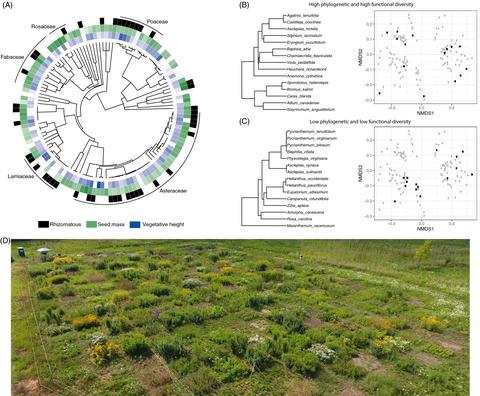Our official English website, www.x-mol.net, welcomes your
feedback! (Note: you will need to create a separate account there.)
Selection on convergent functional traits drives compositional divergence in early succession of a tallgrass prairie restoration experiment
Journal of Ecology ( IF 5.3 ) Pub Date : 2021-11-06 , DOI: 10.1111/1365-2745.13808 Nisa Karimi 1, 2 , Daniel J. Larkin 3 , Mary‐Claire Glasenhardt 1, 4 , Rebecca S. Barak 5 , Evelyn W. Williams 5, 6 , Adrienne R. Ernst 7 , Andrew L. Hipp 1
中文翻译:

在高草草原恢复实验的早期演替中,对收敛功能性状的选择驱动了成分的分歧
更新日期:2021-11-06
Journal of Ecology ( IF 5.3 ) Pub Date : 2021-11-06 , DOI: 10.1111/1365-2745.13808 Nisa Karimi 1, 2 , Daniel J. Larkin 3 , Mary‐Claire Glasenhardt 1, 4 , Rebecca S. Barak 5 , Evelyn W. Williams 5, 6 , Adrienne R. Ernst 7 , Andrew L. Hipp 1
Affiliation

|
- Plant biodiversity is often partitioned into taxonomic diversity (species composition and abundance), phylogenetic diversity (breadth of evolutionary lineages) and functional diversity (resource-use strategies or physical traits). Evaluating the effects and interplay of these dimensions can provide insights into how assembly processes drive compositional changes in plant communities. However, teasing apart the effects of different biodiversity dimensions is challenging in observational studies or retrospective analyses.
- To evaluate how plant phylogenetic and trait history shape community establishment and turnover in restoration of a species-rich North American tallgrass prairie, we conducted an experiment with 127 species planted in assemblages representing three levels of phylogenetic diversity (PD) and two of functional trait diversity (FD), holding starting species richness (SR) fixed. We tested whether PD and FD of planted assemblages predicted species diversity, compositional turnover and selection on functional traits.
- Rank order of initial functional and phylogenetic diversity levels was maintained throughout the experiment, but neither diversity measure correlated positively with species richness by the end of the experiment. Phylogenetic and taxonomic beta diversity increased among all treatments. This increase in compositional beta diversity was associated with directional selection on phylogenetically dispersed functional traits. A set of functional traits associated with competitiveness in tallgrass prairies predicted species' cover for all survey years: stem dry matter content, leaf dry matter content, vegetative height and rhizomatous growth. Although all plots collectively converged on a similar suite of functional traits, functional beta diversity increased among high-FD plots.
- Synthesis. Neither higher functional nor phylogenetic diversity maintained higher species richness (SR) over time in our study. Although SR was not maintained, higher levels of PD and FD were. Both types of diversity shaped the rate at which plots changed in composition over time, with high diversity treatment plots increasing in beta diversity. Selection for traits convergent across the tree of life drove phylogenetic and compositional divergence among plots. While optimization of site-specific functional traits may be most important for maintaining higher SR, our work implies that planting higher initial PD and FD may make grassland restorations more adaptable to site conditions that may be difficult to predict.
中文翻译:

在高草草原恢复实验的早期演替中,对收敛功能性状的选择驱动了成分的分歧
- 植物生物多样性通常分为分类多样性(物种组成和丰度)、系统发育多样性(进化谱系的广度)和功能多样性(资源利用策略或物理特征)。评估这些维度的影响和相互作用可以提供关于组装过程如何推动植物群落组成变化的见解。然而,在观察性研究或回顾性分析中,梳理不同生物多样性维度的影响具有挑战性。
- 为了评估植物系统发育和性状历史在恢复物种丰富的北美高草草原中如何影响群落建立和周转,我们进行了一项实验,其中 127 个物种种植在代表三个系统发育多样性 (PD) 水平和两个功能性状多样性水平的组合中(FD),保持起始物种丰富度(SR)固定。我们测试了种植组合的 PD 和 FD 是否可以预测物种多样性、组成周转和功能性状的选择。
- 在整个实验过程中保持初始功能和系统发育多样性水平的等级顺序,但到实验结束时,两种多样性测量都与物种丰富度呈正相关。所有处理中的系统发育和分类学β多样性增加。组成β多样性的这种增加与系统发育分散的功能性状的定向选择有关。与高草草原竞争力相关的一组功能性状预测了所有调查年份的物种覆盖:茎干物质含量、叶干物质含量、营养高度和根茎生长。尽管所有地块都集中在一组相似的功能特征上,但高 FD 地块的功能性 β 多样性增加。
- 合成。在我们的研究中,随着时间的推移,更高的功能多样性和系统发育多样性都没有保持更高的物种丰富度(SR)。尽管 SR 没有得到维持,但 PD 和 FD 水平更高。两种类型的多样性决定了地块组成随时间变化的速率,高多样性处理地块的β多样性增加。选择在生命之树上趋同的性状推动了地块之间的系统发育和组成差异。虽然优化特定地点的功能性状对于维持较高的 SR 可能是最重要的,但我们的工作意味着种植较高的初始 PD 和 FD 可能会使草地恢复更适应可能难以预测的场地条件。











































 京公网安备 11010802027423号
京公网安备 11010802027423号